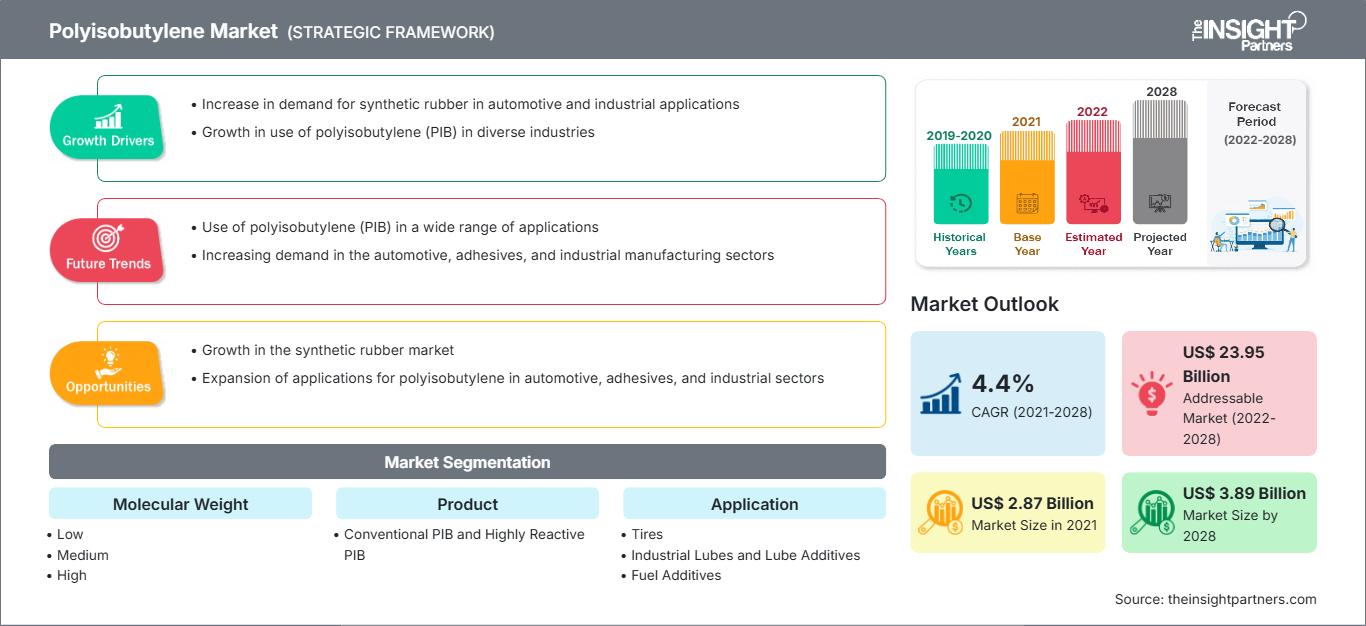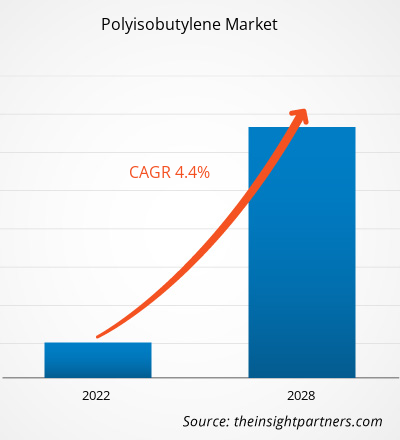[Rapport de recherche] Le marché du polyisobutylène était évalué à 2 871,14 millions de dollars américains en 2021 et devrait atteindre 3 891,16 millions de dollars américains d'ici 2028 ; il devrait croître à un TCAC de 4,4 % entre 2021 et 2028.
Le polyisobutylène (PIB) est un élastomère ou un caoutchouc synthétique. En fonction de sa masse moléculaire, le marché est segmenté en faible, moyen et élevé. C'est un liquide visqueux polyvalent, non toxique et blanc comme l'eau. Le polyisobutylène peut augmenter l'adhésivité, offrir une imperméabilité, améliorer l'indice de viscosité et fournir une excellente isolation électrique. En 2020, l'Amérique du Nord détenait la plus grande part de chiffre d'affaires du marché mondial du polyisobutylène. La demande croissante de diverses applications, telles que les transports, l'agrochimie, l'électricité et les adhésifs, stimule la croissance du marché en Amérique du Nord. Le polyisobutylène est de plus en plus utilisé dans les secteurs du transport, de l’alimentation et de la construction car il offre une faible perméabilité aux gaz, une excellente résistance à la traction, une résistance chimique élevée et une rigidité accrue.
Personnalisez ce rapport en fonction de vos besoins
Vous bénéficierez d’une personnalisation sur n’importe quel rapport - gratuitement - y compris des parties de ce rapport, ou une analyse au niveau du pays, un pack de données Excel, ainsi que de profiter d’offres exceptionnelles et de réductions pour les start-ups et les universités
Marché du polyisobutylène: Perspectives stratégiques

- Obtenez les principales tendances clés du marché de ce rapport.Cet échantillon GRATUIT comprendra une analyse de données, allant des tendances du marché aux estimations et prévisions.
Vous bénéficierez d’une personnalisation sur n’importe quel rapport - gratuitement - y compris des parties de ce rapport, ou une analyse au niveau du pays, un pack de données Excel, ainsi que de profiter d’offres exceptionnelles et de réductions pour les start-ups et les universités
Marché du polyisobutylène: Perspectives stratégiques

- Obtenez les principales tendances clés du marché de ce rapport.Cet échantillon GRATUIT comprendra une analyse de données, allant des tendances du marché aux estimations et prévisions.
Impact de la pandémie de COVID-19 sur le marché du polyisobutylène
La pandémie de COVID-19 a radicalement modifié la situation du secteur des produits chimiques et des matériaux et a eu un impact négatif sur la croissance du marché du polyisobutylène.
L'industrie mondiale des produits chimiques et des matériaux est l'une des principales industries à souffrir de graves perturbations liées à la pandémie, telles que des ruptures de chaîne d'approvisionnement, des annulations d'événements technologiques et des fermetures de bureaux. Les interdictions de voyager imposées par les pays d'Europe, d'Asie et d'Amérique du Nord affectent les collaborations et les partenariats commerciaux. Tous ces facteurs devraient avoir un impact négatif sur l'industrie de l'électronique et des produits chimiques et des matériaux, ce qui entrave la croissance de divers marchés liés à ces industries. Cependant, alors que les économies prévoient de relancer leurs activités, la demande de polyisobutylène devrait augmenter à l'échelle mondiale. La demande de polyisobutylène des secteurs des lubrifiants industriels et des additifs pour lubrifiants en aval a commencé à augmenter avec la reprise des activités commerciales et la levée des mesures de confinement à l'échelle mondiale. Perspectives du marché : L'industrie automobile devrait stimuler la croissance du marché pendant la période de prévision.
Pour l'industrie automobile, la performance des moteurs dans leurs fonctions quotidiennes est importante. L'industrie automobile est le marché clé pour plusieurs types d'additifs pour carburant depuis de nombreuses années. La part de l'automobile a toujours été supérieure à celle des autres segments de marché des additifs pour carburant en raison du manque d'alternatives efficaces aux combustibles fossiles et de la croissance de l'économie de la classe moyenne. L'importance relative de l'aviation pour les additifs pour carburant a augmenté ces dernières années, augmentant ainsi la demande de polyisobutylène.
Perspectives d'application
En fonction des applications, le marché mondial du polyisobutylène est segmenté en pneus, lubrifiants et additifs pour lubrifiants industriels, additifs pour carburant, adhésifs et produits d'étanchéité, etc. Le segment des lubrifiants et additifs industriels détenait la plus grande part de marché en 2020. Le polyisobutylène (PIB) réagit avec l'anhydride maléique pour former l'anhydride polyisobuténylsuccinique (PIBSA), un composant de base des dispersants dans les huiles lubrifiantes et des détergents dans les carburants. Son autre variante, le polyisobutylène-succinimide (PIBSI), dérivé du polyisobutylène (PIB), agit comme émulsifiant antioxydant dans les fluides solubles pour le travail des métaux et comme composant des additifs lubrifiants. Les PIB brûlent également plus proprement, ce qui les rend idéaux pour une utilisation dans les huiles pour moteurs deux temps et les applications marines où les lubrifiants sont soumis aux gaz de fuite agressifs des gros moteurs diesel.
BASF SE, Braskem SA, Daelim Industrial Petrochemical Division, Ineos AG, Infineum International Limited, Kothari Petrochemicals, Sibur Holding PJSC, Kemat Polybutenes, The Lubrizol Corporation et TPC Group comptent parmi les principaux acteurs du marché mondial du polyisobutylène. Les acteurs du marché s'attachent à développer des offres de produits innovants et de haute qualité pour répondre aux exigences des clients.
PolyisobutylèneAperçu régional du marché du polyisobutylène
Les tendances régionales et les facteurs influençant le marché du polyisobutylène tout au long de la période de prévision ont été analysés en détail par les analystes de The Insight Partners. Cette section aborde également les segments et la géographie du marché du polyisobutylène en Amérique du Nord, en Europe, en Asie-Pacifique, au Moyen-Orient et en Afrique, ainsi qu'en Amérique du Sud et en Amérique centrale.
Portée du rapport sur le marché du polyisobutylène
| Attribut de rapport | Détails |
|---|---|
| Taille du marché en 2021 | US$ 2.87 Billion |
| Taille du marché par 2028 | US$ 3.89 Billion |
| TCAC mondial (2021 - 2028) | 4.4% |
| Données historiques | 2019-2020 |
| Période de prévision | 2022-2028 |
| Segments couverts |
By Poids moléculaire
|
| Régions et pays couverts | Amérique du Nord
|
| Leaders du marché et profils d'entreprises clés |
|
Densité des acteurs du marché du polyisobutylène : comprendre son impact sur la dynamique commerciale
Le marché du polyisobutylène connaît une croissance rapide, portée par une demande croissante des utilisateurs finaux, due à des facteurs tels que l'évolution des préférences des consommateurs, les avancées technologiques et une meilleure connaissance des avantages du produit. Face à cette demande croissante, les entreprises élargissent leur offre, innovent pour répondre aux besoins des consommateurs et capitalisent sur les nouvelles tendances, ce qui alimente la croissance du marché.

- Obtenez le Marché du polyisobutylène Aperçu des principaux acteurs clés
- Analyse historique (2 ans), année de base, prévision (7 ans) avec TCAC
- Analyse PEST et SWOT
- Taille du marché Valeur / Volume - Mondial, Régional, Pays
- Industrie et paysage concurrentiel
- Ensemble de données Excel
Rapports récents
Témoignages
Raison d'acheter
- Prise de décision éclairée
- Compréhension de la dynamique du marché
- Analyse concurrentielle
- Connaissances clients
- Prévisions de marché
- Atténuation des risques
- Planification stratégique
- Justification des investissements
- Identification des marchés émergents
- Amélioration des stratégies marketing
- Amélioration de l'efficacité opérationnelle
- Alignement sur les tendances réglementaires






















 Obtenez un échantillon gratuit pour - Marché du polyisobutylène
Obtenez un échantillon gratuit pour - Marché du polyisobutylène